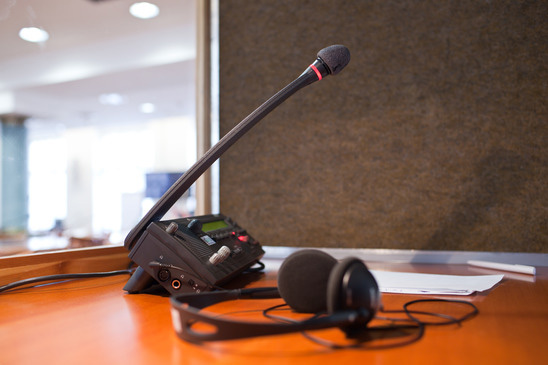Techniques
Our interpretation techniques and motto
The realm of interpretation is very wide and diverse; different interpretation techniques can be required according to the specific situations and events.
The most known and appreciated method is simultaneous interpretation, where the interpreter renders the message into the target-language while the source-language speaker continuously speaks. Some technical equipment (translation booths, microphones, etc.) is necessary to perform such task and unfortunately it is not always available. For this reason many resort to other interpreting techniques.
Here is a brief outline of the various possible techniques:
Simultaneous interpreter
The simultaneous interpreter is the professional who represents the most well known system to render the message into the target-language as quickly as possible, while the source-language speaker continues to speak. Modifying the tone of their voice, simultaneous interpreters can also convey the emotions of the speaker, creating a pleasant, personal atmosphere. Normally, in the booth there are two interpreters who work in turns at interpreting the speaker’s speech into the target-language, quite simultaneously. Usually, this technique results in interpreting only into the target-language (from language A to language B) and the two interpreters take turns; a bit like the pilot and co-pilot of an airplane. Simultaneous interpreters work in the background: they can be heard in the headphones and probably not seen.

Consecutive interpreter
In many occasions and events, a consecutive interpreter may be the best choice: he or she acts as a direct intermediary between people who need interpretation. In this case the interpretation technique involves rendering the message after the interlocutor or speaker has finished a couple of sentences at a time. Normally, during the speech, the interpreter takes notes and then renders the content of the message into the other language. Occasions in which this type of interpreting is required include receptions, official visits and fairs, meetings or conferences for a small group, visits to companies and institutions, and meetings between representatives of the public or private sector. The task of a consecutive interpreter is to guarantee mutual understanding between the parts, both in terms of interpersonal relationship and the accuracy of the contents.

Community interpreter
Often, and unjustly, this type of interpreter is defined as being the “poor relation” among the interpreters. Community interpreters work within a specific environment, such as a hospital or a penal institution, though in the sector jargon with “community interpreter” we more specifically identify the person who provides their interpretation services in a hospital.
The reason why they are often defined and the “poor relation”, depends on the fact that hospitals usually do not resort to professional interpreters but rather to their own personnel who have a certain knowledge (though often insufficient) of a foreign language. It is not an uncommon fact, especially when interpreting the languages of developing countries is needed, that hospitals resort to foreign janitors and workers for such services, without paying a remuneration for their extra work.
Fortunately, in recent years, the importance of hiring a “professional” interpreter has been acknowledged and has led ever more European hospitals to hire professional services. In healthcare and emergency situations, a language barrier can hinder intervention or slow down the administration of suitable treatment or procedures to patients, whether these are tourists, immigrant workers or any other foreigner. In such cases, specialized interpreters allow the necessary understanding between medical personnel and patients, and so doing, play an essential role in healthcare. To carry out such a task the “community interpreter” does not only have an exceptional knowledge of the specific medical terms and language, but also, great sensitivity and sensibility to exactly render the nuances of what is said. Last but not least, he or she also contributes in establishing the special relationship of trust between physician and patient.

"Chuchotage" interpreter
Working as an interpreter for a law court, for the police or other institutions usually requires alternating consecutive interpretation with “chuchotage “(the French term meaning “to whisper”).
This is the technically-simplified version of simultaneous interpretation, where the contents of the utterance are rendered into the target-language and whispered into the listener’s ear, without using any technical device.
A similar interpretation technique, identified with the same name, is used in case of small or medium small group events where several participants need interpretation but where a booth is not available or cannot be provided due to the location of the meeting, for example on the premises of a factory and similar locations, or also due to cost. In these cases participants will use “bidoules” (a French term that indicates a gadget), which consist in a microphone and earphones similar to those used during guided tours in a museum. The interpreter uses the same technique as that to whisper into the listener’s ear with the only difference that he or she will speak into a microphone. The listeners will hear the translation through their earphones.
This type of interpretation unfortunately does not allow the same quality as that provided from a booth, since, especially in the open-air and in factories, background noise makes it difficult for the interpreter to clearly hear the speaker.

Negotiation Interpreter
The negotiation interpreter is normally seated at a table with the participants in a business meeting and must interpret what is said during negotiations.
The particularity of this type of service is that the language direction of interpretation switches continually between the two languages (from language A to language B and back to language A). What often happens is that the participants in the negotiations speak amongst them in a not perfectly correct “business English”, while the interpreter remains silent only to intervene when needed. In this case the technique adopted is that of consecutive interpreting and partly “chuchotage”.

